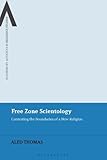Free Zone Scientology : Contesting the Boundaries of a New Religion.
Material type: TextSeries: Bloomsbury advances in religious studiesPublication details: London : Bloomsbury Publishing Plc, 2021.Description: 1 online resource (166 pages)Content type:
TextSeries: Bloomsbury advances in religious studiesPublication details: London : Bloomsbury Publishing Plc, 2021.Description: 1 online resource (166 pages)Content type: - 9781350182561
- 1350182567
- 1350182559
- 9781350182554
- 1350182575
- 9781350182578
- 299/.93609 23
- BP605.S2 T565 2021eb
- online - EBSCO
| Item type | Current library | Call number | URL | Status | Notes | Barcode | |
|---|---|---|---|---|---|---|---|
 eBook
eBook
|
Biblioteca "Angelicum" Pont. Univ. S.Tommaso d'Aquino Nuvola online | online - EBSCO (Browse shelf(Opens below)) | Online access | Not for loan (Accesso limitato) | Accesso per gli utenti autorizzati / Access for authorized users | (ebsco)2738651 |
Browsing Biblioteca "Angelicum" Pont. Univ. S.Tommaso d'Aquino shelves, Shelving location: Nuvola online Close shelf browser (Hides shelf browser)
Print version record.
Preface -- 1. Introduction: Researching 'Scientologies' -- Part 1: From Scientology to Scientologies -- 2. The Church of Scientology and the 'Free Zone': A Complex Relationship -- 3. Auditing and the 'Tech': The Basics -- 4. 'You are YOU in a body': Negotiating the Self in Scientology -- Part 2: Fluidity and Boundaries -- 5. Authenticity and Innovation: The 'True Tech' and 'Mistakes by Hubbard' -- 6. 'Doing Scientology': E-Meters, Objects, and Material Culture -- 7. Moving Forward: Reflections on Free Zone Scientology and the Wider Study of Religions -- 8. Conclusion -- Appendix A -- Appendix B -- Notes -- References -- Index
"In the first major academic study of Free Zone Scientology, Aled Thomas analyses modern issues surrounding boundaries and fluidity in contemporary Scientology. By using the Scientologist practice of 'auditing' as a case study, this book explores the ways in which new types of 'Scientologies' can emerge. The notion of Free Zone Scientology is characterised by its horizontal structure, in contrast to the vertical-hierarchy of the institutional Church of Scientology. With this in mind, Thomas explores the Free Zone as an example of a developing and fluid religion, directly addressing questions concerning authority, leadership, and material objects. This book, by maintaining a double-focus on the top-down hierarchy of the Church of Scientology and the horizontal-fluid nature of the Free Zone, breaks away from previous research on new religions, with have tended to focus either on new religions as indices of broad social processes, such as secularization or globalization, or as exemplars of exotic processes, such as charismatic authority and brainwashing. Instead, Thomas adopts auditing as a method of providing an in-depth case study of a new religion in transition and transformation in the 21st century. This opens the study of contemporary and new religions to a series of new questions around hybrid religions (sacred and secular), and acts as a framework for the study of similar movements formed in recent decades."-- Provided by publisher
Includes bibliographical references (pages 176-186) and index.









